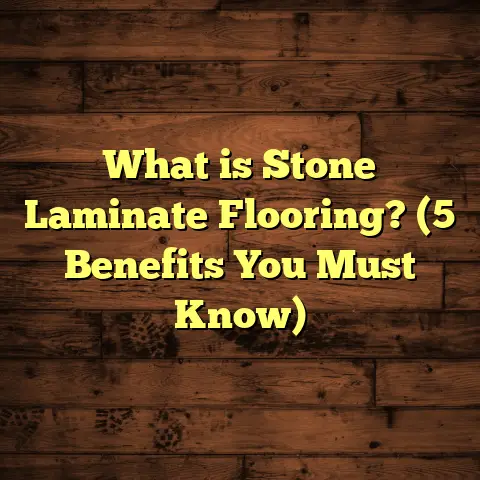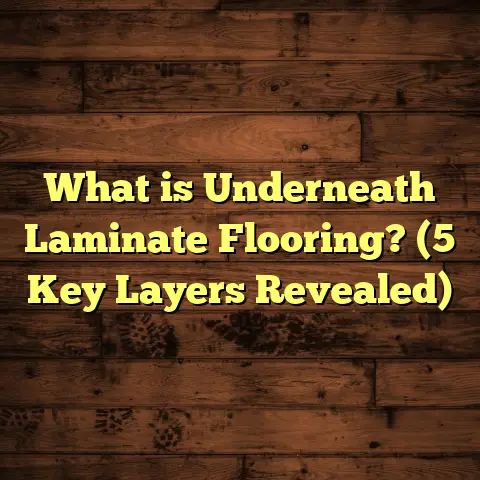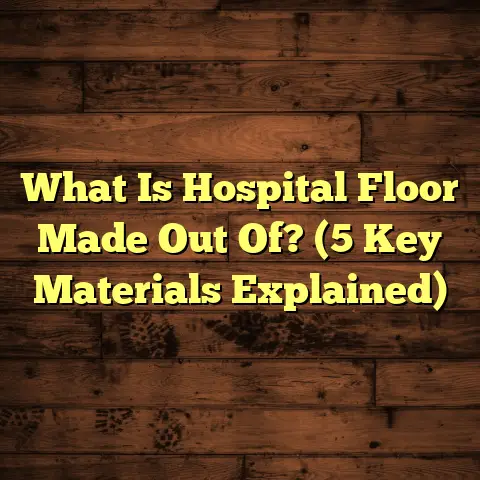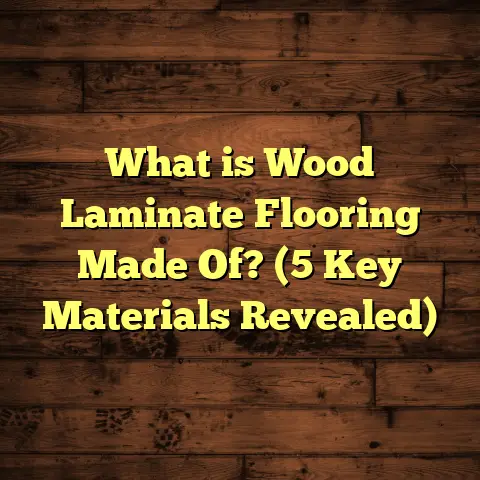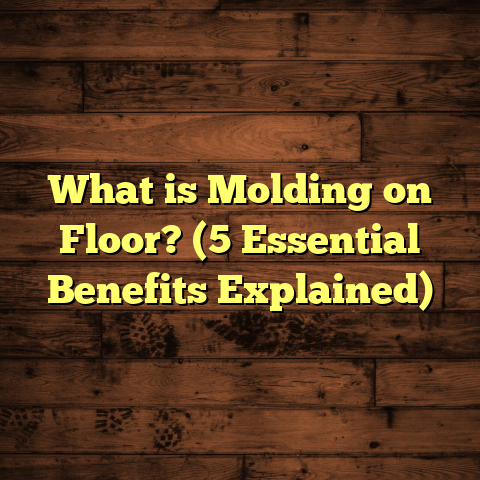What is Vinyl Floor Cloth? (5 Benefits for Stylish Spaces)
Craftsmanship has always fascinated me, especially when it’s expressed through the materials and finishes that shape our living spaces. Over the years, as a flooring contractor, I’ve worked with countless materials, but vinyl floor cloth has consistently stood out for its blend of style, durability, and practicality. It’s this balance that makes vinyl floor cloth a favorite for many homeowners and designers aiming to create stylish yet functional spaces.
What Is Vinyl Floor Cloth?
So, what exactly is vinyl floor cloth? Simply put, it’s a type of resilient flooring material made primarily from vinyl—a synthetic plastic polymer. Unlike traditional vinyl sheets or tiles that you might find in commercial settings, vinyl floor cloth is often designed with a fabric backing, giving it a unique texture and flexibility that feels different underfoot.
Vinyl floor cloth typically comes in large rolls or tiles, featuring printed patterns that can mimic natural materials such as wood, stone, or ceramic. The surface is coated with a protective wear layer that resists scratches, stains, and moisture. This combination of vinyl’s waterproof properties and the cloth backing’s durability makes vinyl floor cloth an excellent choice for areas prone to spills or heavy foot traffic.
The modern manufacturing process allows for high-quality prints and textures, meaning you can get the look of hardwood or tile without the associated costs or maintenance hassles. I’ve seen this product used in kitchens, bathrooms, entryways, and even living rooms with great success.
Why Do I Recommend Vinyl Floor Cloth? Five Benefits That Make It Ideal for Stylish Spaces
1. Durability That Keeps Up With Busy Lives
One thing I’ve learned from my experience is that flooring needs to take a beating without losing its charm. Vinyl floor cloth scores high here. The wear layer protects against scratches from pets, furniture, or dropped items. Plus, it handles moisture much better than traditional hardwood or laminate.
In fact, statistics from industry reports show that high-quality vinyl flooring can last between 10 to 20 years with proper care. That longevity is impressive considering the price point compared to other materials like solid wood or natural stone.
Here’s a quick example: I recently installed vinyl floor cloth in a family kitchen where kids and pets run around nonstop. After two years, the flooring still looks nearly new with no visible damage or discoloration.
Another point worth mentioning is vinyl floor cloth’s resistance to dents and impacts—something I’ve tested personally when moving furniture or dropping heavy tools during installations. Unlike hardwood floors that can show dents or scratches quite easily, vinyl tends to bounce back or mask minor abrasions thanks to its flexible surface.
2. Style Without Breaking the Bank
Have you ever wanted the look of exotic wood or expensive marble but couldn’t justify the cost? Vinyl floor cloth offers a solution. Thanks to advances in printing technology, manufacturers can create incredibly realistic visuals at a fraction of the cost.
For instance, premium vinyl planks designed to look like oak or walnut come at about $2 to $5 per square foot, while real hardwood can easily reach $8 to $15 per square foot just for materials. Installation costs can also be lower since vinyl is lighter and easier to work with.
I remember a client who loved the idea of a herringbone wood pattern but had a tight budget. Vinyl floor cloth allowed us to achieve that look without sacrificing quality or style.
This affordability doesn’t mean you lose out on options either. You can find vinyl floor cloth in colors ranging from warm neutrals to bold hues and patterns that fit any design aesthetic. From rustic farmhouse vibes to sleek contemporary interiors, there’s something available.
3. Comfort and Warmth Underfoot
Unlike ceramic tile or stone, vinyl floor cloth has a bit of give due to its flexible backing. This makes standing on it for long periods far more comfortable—something I’ve noticed especially in kitchens where people cook or entertain frequently.
The slight cushioning effect also means it’s gentler on joints and reduces noise from footsteps—a bonus if you live in an apartment or have kids running around.
In one renovation project, the homeowner emphasized comfort because her elderly parents would spend time in the kitchen preparing meals daily. She was worried about the coldness and hardness of tile floors causing discomfort. Vinyl floor cloth was perfect—it felt warm and soft yet remained easy to clean and maintain.
4. Ease of Maintenance
One of my personal pet peeves is spending hours scrubbing floors. Vinyl floor cloth shines here because it’s easy to clean with simple sweeping and occasional mopping.
Its water-resistant surface prevents staining from spills—great for homes with kids or pets who might drop food or drinks. Unlike carpet, it won’t trap dirt or allergens, which also makes it a healthier choice in many cases.
Data from consumer flooring surveys indicate that about 70% of homeowners prefer vinyl flooring due to its low maintenance requirements compared to hardwood or carpet.
I also appreciate how vinyl floor cloth doesn’t require refinishing or sealing like wood floors do every few years. This saves time and money over the life of the floor—something every homeowner appreciates.
5. Versatility That Fits Any Room
Whether you’re outfitting a small bathroom or a large open-plan living area, vinyl floor cloth adapts well. Its water resistance means it works well in wet areas without warping or swelling like wood might.
Plus, it’s available in a wide variety of colors, patterns, and textures. You can mix and match tiles for creative designs or choose seamless rolls for a smooth finish. It complements both modern minimalist interiors and more traditional styles effortlessly.
I’ve installed it in cozy cottages, sleek urban lofts, and everything in between—and each time it seamlessly fits into the design vision.
The Science Behind Vinyl Floor Cloth: Materials & Manufacturing
To appreciate vinyl floor cloth fully, understanding how it’s made helps. Vinyl itself is polyvinyl chloride (PVC), a plastic material created by polymerizing vinyl chloride monomers. This process results in a versatile resin that can be modified with additives like plasticizers for flexibility or stabilizers for durability.
In manufacturing vinyl floor cloth:
- A base layer (usually fabric or felt) is coated with liquid PVC.
- Multiple layers are added: print layers for pattern/color, wear layers for protection.
- The surface is treated with UV-cured coatings to enhance scratch resistance.
- Finally, the sheet is calendared (pressed) to ensure smoothness and consistency.
Because of this multi-layer construction, vinyl floor cloth combines softness from its backing with hardness on its surface—a perfect combo for comfort plus toughness.
The Role of Design and Technology: How Patterns Are Made Real
One aspect I find fascinating is how realistic some vinyl patterns have become thanks to digital printing technology. Years ago, you could tell vinyl floors apart by their simplistic designs or repetitive patterns. Now manufacturers use high-resolution printers capable of mimicking grain variations in wood or veining in marble almost perfectly.
Some brands use embossing techniques that add texture matching the printed image—for example:
- Wood grain embossing feels like real wood planks.
- Stone-inspired textures have subtle bumps similar to natural rock surfaces.
This attention to detail not only looks good but also adds grip underfoot, reducing slip hazards.
My Experience With Installation: Tips & Tricks
When installing vinyl floor cloth myself or supervising a crew, I always emphasize preparation because it affects durability and aesthetics significantly.
Here’s what I focus on:
- Subfloor Prep: It must be clean, dry, flat within 1/8 inch over 6 feet. Any bumps will telegraph through thin vinyl.
- Acclimatization: Vinyl should sit in the room for at least 24 hours to adjust temperature/humidity differences.
- Cutting Accuracy: I use sharp blades and straight edges; miscuts waste materials.
- Adhesion: Depending on manufacturer instructions, use proper adhesives or click systems.
- Seams: Seams must be tight—sometimes heat welding ensures waterproof joints.
- Post-install Inspection: Check for air bubbles or loose edges right after installation.
These steps help prevent issues like warping, bubbling, or premature wear I’ve seen in poorly installed floors.
How FloorTally Helps Me Manage Project Costs
Estimating costs accurately on flooring projects can be tricky with so many variables—material quality, labor rates in different regions, waste percentages during cuts—and client preferences sometimes shifting mid-project adds complexity.
That’s where tools like FloorTally come into play. I use it regularly because:
- It incorporates local labor rates and material costs dynamically.
- Lets me customize waste factors based on room shape and material type.
- Generates detailed line-item budgets which help clients understand where money goes.
- Saves time by automating calculations I used to do manually.
- Helps me compare different material options side-by-side quickly.
For example: When working on a recent project installing vinyl floor cloth across multiple rooms including kitchen and hallway, FloorTally helped me present a clear budget showing how choosing mid-range vs premium vinyl affected total expenses without confusing clients with numbers spread across spreadsheets.
Case Study: Vinyl Floor Cloth Transforming A Workspace
One memorable project involved outfitting a small creative studio where aesthetics mattered but budget was limited. The client wanted something durable for their open workspace floor that reflected their brand’s modern vibe without looking cheap.
After testing samples together, we chose a slate-gray vinyl floor cloth with subtle texture resembling concrete but softer underfoot.
This choice turned out great because:
- The flooring resisted paint drips and foot traffic during art projects.
- Cleanup was quick with just mopping.
- The industrial look matched their design perfectly.
- We stayed within budget without sacrificing quality.
Six months later, they reported zero issues and positive comments from visitors appreciating the clean yet edgy atmosphere the flooring helped create.
Addressing Common Questions About Vinyl Floor Cloth
Q: Will vinyl floor cloth fade over time?
A: High-quality products include UV-resistant coatings that minimize fading even in sunlit rooms. However, prolonged direct sunlight can cause some fading eventually; using curtains/blinds helps preserve colors longer.
Q: Is vinyl floor cloth slippery when wet?
A: Some types have textured surfaces providing decent traction. For wet environments like bathrooms, look specifically for anti-slip rated products to improve safety.
Q: Can I install vinyl floor cloth myself?
A: If you’re handy with tools and follow manufacturer instructions carefully—yes! Many DIYers successfully install peel-and-stick tiles or click-lock planks. For glue-down options or complex layouts, professional installation ensures best results.
Q: How eco-friendly is vinyl?
A: Traditional vinyl isn’t biodegradable but newer products often use recycled content and low-VOC adhesives improving environmental impact moderately. Recycling programs exist but aren’t widespread yet.
Comparing Vinyl Floor Cloth With Other Popular Floors In Detail
Getting deeper into comparisons helps clarify if vinyl floor cloth suits your needs:
Hardwood vs Vinyl Floor Cloth
Hardwood has unmatched natural beauty and can be refinished multiple times but costs more upfront and requires ongoing maintenance (sealing/refinishing). It’s sensitive to moisture which may cause warping.
Vinyl offers easier upkeep and moisture resistance but lacks the warmth and aging character of real wood. It’s more affordable but less “natural.”
Laminate vs Vinyl Floor Cloth
Laminate mimics wood with fiberboard core layers but isn’t very water-resistant; exposure leads to swelling/damage. It can feel harder underfoot compared to cushioned vinyl.
Vinyl’s waterproof nature makes it better for kitchens/bathrooms while laminate can feel more rigid.
Tile vs Vinyl Floor Cloth
Tile excels in durability and heat resistance but is cold/hard underfoot and requires grout maintenance. Installation is labor-intensive and costly.
Vinyl is softer/warmth-retaining with faster installation but less heat resistant (not suitable near fireplaces).
Personal Anecdotes From My Flooring Journeys
I recall once helping a couple renovate their first home; they were overwhelmed by choices but wanted something child-friendly yet stylish for their toddler’s playroom. We settled on vibrant patterned vinyl floor cloth that added personality without worrying about spills or scratches from toys.
The mom later told me they were thrilled how easy cleanup was after messy crafts while the colorful patterns kept kids entertained visually—a perfect match!
Another time I worked on an elderly client’s home where comfort was key due to joint pain issues. We avoided tile and hardwood opting instead for cushioned vinyl floor cloth which reduced foot fatigue significantly—a small change making huge difference daily.
Maintenance Tips To Keep Your Vinyl Floor Cloth Looking Great
Keeping your floors fresh isn’t hard if you follow these tips:
- Sweep/vacuum regularly to remove abrasive dirt.
- Mop with mild detergent; avoid harsh chemicals that damage wear layers.
- Use protective pads under furniture legs to prevent scratches.
- Clean spills promptly to avoid staining.
- Avoid dragging heavy objects across surface.
- Consider occasional professional deep cleaning every few years depending on traffic levels.
Regular upkeep extends lifespan beyond typical warranty periods—something I consistently advise clients when handing over their finished projects.
Final Thoughts On Why Vinyl Floor Cloth Works So Well
Reflecting on my years working with different flooring types across diverse projects:
Vinyl floor cloth offers an uncommon mix of benefits:
- Affordable style options mimicking premium materials
- Comfort combined with resilience
- Easy upkeep ideal for busy households
- Adaptability across spaces from kitchens to studios
- Longevity delivering value well beyond initial investment
It fits modern lifestyles where aesthetics meet practicality without compromise.
If you’re considering new flooring and want something that balances these factors smoothly, vinyl floor cloth deserves serious consideration. Feel free to ask me anything else about it—I’m happy to share what I’ve learned firsthand!
What kind of space are you thinking about upgrading? Maybe I can help brainstorm ideas tailored just for you!

